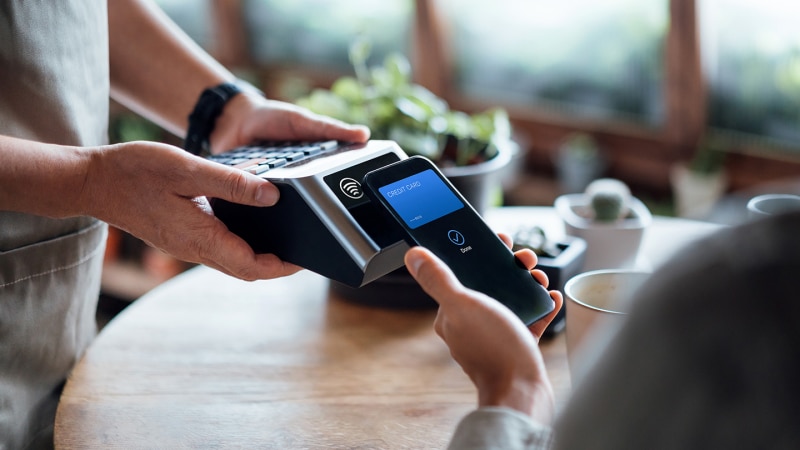What to know about the different types of digital payments

Quick insights
- There are many forms of digital payments.
- Common digital payment methods include credit and debit cards, peer-to-peer payment apps and digital wallets.
- Many digital payments have security features like encryption, two-factor authentication and fraud detection to help keep payment information secure.
A company called First Virtual Holdings created the first online payment system in 1994. A lot has changed since the early 1990s when it comes to making digital payments. What was once a new concept is now a routine way to exchange money. And as digital payment technology has advanced, consumers have been given options for how to pay digitally. In this article, we’ll explore a few of them.
Introduction to digital payments
Digital payments allow you to pay for goods and services electronically. There has been a shift in recent years from traditional payment methods—like cash—to digital options, with convenience and speed helping to make this shift. The COVID-19 pandemic also accelerated the adoption of electronic payment methods as many people wanted to avoid passing physical cash back and forth in 2020.
As technology advances and the average consumer becomes more comfortable with digital payments, there have been changes and additions to how you can pay electronically.
Exploring the different types of digital payments
There’s more than one way to pay digitally. Here are some of the most common forms of digital payments:
Credit and debit cards
These are likely the most common form of digital payments. They involve the transfer of funds from the payer to the payee's account using a credit or debit card, either physically at a point-of-sale terminal or by entering card information at a merchant’s website.
Debit and credit cards have been widely accepted for quite some time, but how you complete a transaction with a card has changed over the years. Many cards come with three ways to pay digitally:
- Magnetic strip: payment info is read when you swipe your card
- Chip: payment info is read when you insert your card
- Contactless radio-frequency identification (RFID) technology: payment info is read when you tap your card
Whether you need to swipe, insert or tap will likely depend on the card reader you’re using for a point-of-sale purchase.
Mobile payments
Mobile payments are transactions made through a mobile device, such as a smartphone or tablet, often with apps or digital wallets. This can include payments made through mobile banking apps and point-of-sale systems.
Mobile payments can be made using various methods, including SMS-based payments, mobile web payments and app-based payments. Some examples of mobile payments include paying for a coffee using a QR code at a café, transferring money via a mobile banking app or completing an in-app purchase.
Digital wallets
Digital wallets are applications that store payment information and more on a mobile device. Popular digital wallets include Apple Pay, Google Wallet, and Samsung Pay, which come preloaded on most new cell phones.
Digital wallets can store multiple types of payment information, including credit cards, debit cards and gift cards. In addition, they can store plane boarding passes, coupons, State ID cards, event tickets, hotel reservations and more.
Peer-to-peer payment apps
Peer-to-peer payment or cash apps allow for the transfer of funds electronically between individuals. They are often apps you can download, or they can be integrated with your online bank account.
Many people choose to use peer-to-peer payment apps for their speed and convenience. It is often easier to transfer money from your phone in a few clicks than it is to carry cash and make change if needed.
Contactless payments
Contactless payments are transactions made by tapping a card, smartphone or wearable device near a compatible point-of-sale terminal. Contactless payments work by transmitting payment information wirelessly when a compatible device is held close to the terminal. This digital payment method includes options like contactless credit and debit cards or digital wallets.
Comparing e-payments and digital payments
E-payments and digital payments may be used interchangeably, but they are different. E-payments refer to transactions conducted electronically and can include online bank transfers, digital checks and credit and debit card payments. Digital payments, on the other hand, are a subset of e-payments that specifically involve digital technologies and platforms, such as mobile wallets and app-based payments. Essentially, all digital payments are e-payments, but not all e-payments are digital payments.
E-payments often happen online, whereas digital payments can happen anywhere. In addition, digital payments often have security features that include:
- Encryption: This is the process of converting your financial data into a coded format to help prevent unauthorized access, ensuring that only authorized parties can read it.
- Two-factor authentication: This is a security process that requires two different forms of identification to verify a user's identity, typically combining something they know (like a password) with something they have (like a mobile device).
- Fraud detection: Digital payment platforms use advanced algorithms and round-the-clock monitoring to help detect and prevent fraudulent transactions by using machine learning, data analytics and behavioral analysis to find unusual activity.
In summary
Digital payments have been a common way to pay for goods and services. There are many forms of digital payments, including credit and debit cards, peer-to-peer payment apps and digital wallets. Many digital payments have security features like encryption, two-factor authentication and fraud detection to help keep payment information secure.



